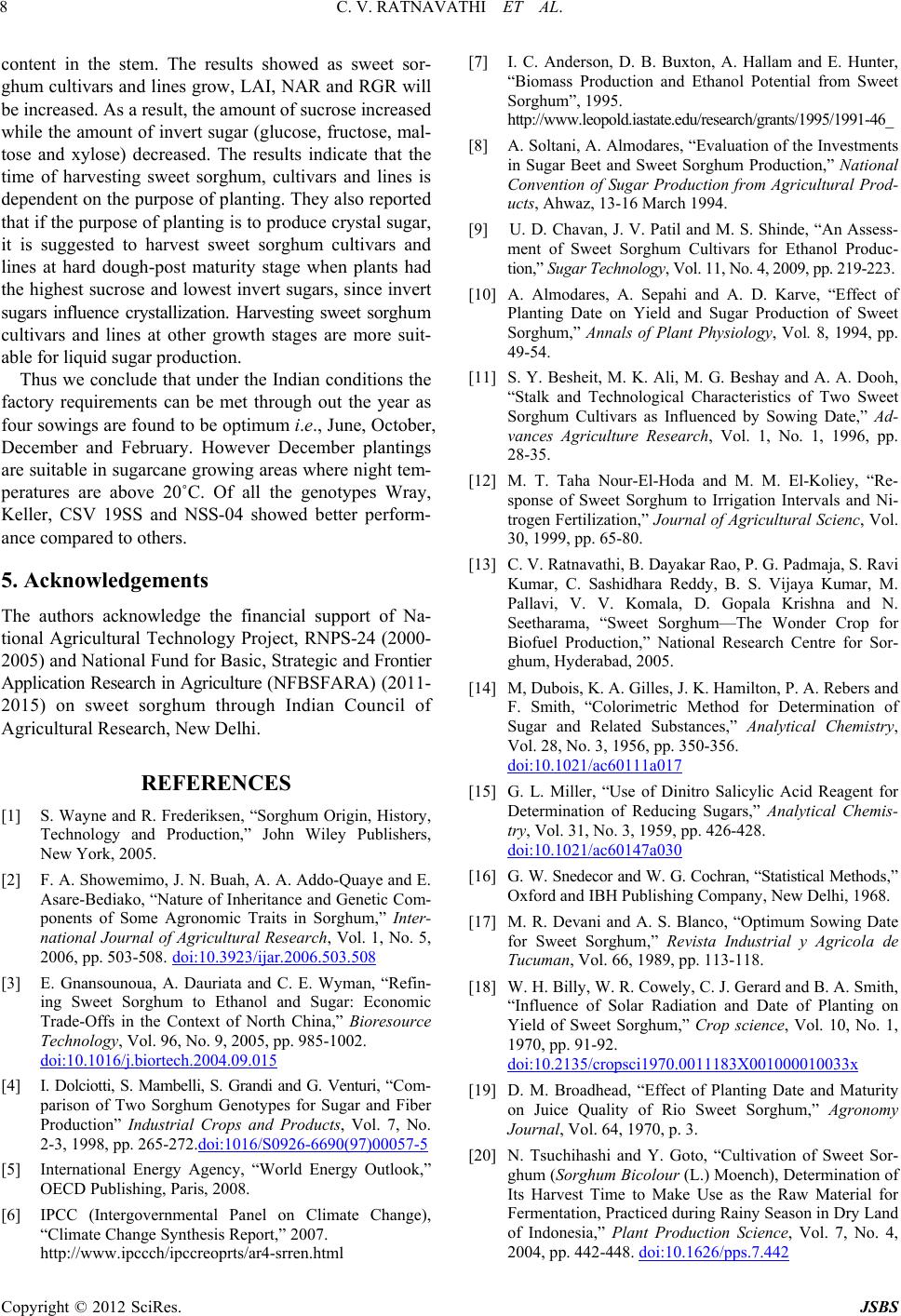
C. V. RATNAVATHI ET AL.
8
content in the stem. The results showed as sweet sor-
ghum cultivars and lines grow, LAI, NAR and RGR will
be increased. As a result, the amount of sucrose increased
while the amount of invert sugar (glucose, fructose, mal-
tose and xylose) decreased. The results indicate that the
time of harvesting sweet sorghum, cultivars and lines is
dependent on the purpose of planting. They also reported
that if the purpose of plan ting is to p roduce crystal sug ar,
it is suggested to harvest sweet sorghum cultivars and
lines at hard dough-post maturity stage when plants had
the highest sucrose and lowest invert sugars, since invert
sugars influence crystallization. Harvesting sweet sorghum
cultivars and lines at other growth stages are more suit-
able for liquid sugar production.
Thus we conclude that under the Indian conditions the
factory requirements can be met through out the year as
four sowing s are found to be o ptimum i.e., June, October,
December and February. However December plantings
are suitable in sugarcane growing areas where night tem-
peratures are above 20˚C. Of all the genotypes Wray,
Keller, CSV 19SS and NSS-04 showed better perform-
ance compared to others.
5. Acknowledgements
The authors acknowledge the financial support of Na-
tional Agricultural Technology Project, RNPS-24 (2000-
2005) and National Fund for Basic, Strategic and Frontier
Application Resear ch in Agriculture (N FB SF AR A) ( 20 11 -
2015) on sweet sorghum through Indian Council of
Agricultural Research, New Delhi.
REFERENCES
[1] S. Wayne and R. Frederiksen, “Sorghum Origin, History,
Technology and Production,” John Wiley Publishers,
New York, 2005.
[2] F. A. Showemimo, J. N. Buah, A. A. Addo-Quaye and E.
Asare-Bediako, “Nature of Inheritance and Genetic Com-
ponents of Some Agronomic Traits in Sorghum,” Inter-
national Journal of Agricultural Research, Vol. 1, No. 5,
2006, pp. 503-508. doi:10.3923/ijar.2006.503.508
[3] E. Gnansounoua, A. Dauriata and C. E. Wyman, “Refin-
ing Sweet Sorghum to Ethanol and Sugar: Economic
Trade-Offs in the Context of North China,” Bioresource
Technology, Vol. 96, No. 9, 2005, pp. 985-1002.
doi:10.1016/j.biortech.2004.09.015
[4] I. Dolciotti, S. Mambelli, S. Grandi and G. Venturi, “Com-
parison of Two Sorghum Genotypes for Sugar and Fiber
Production” Industrial Crops and Products, Vol. 7, No.
2-3, 1998, pp. 265-272.doi:1016/S0926-6690(97)00057-5
[5] International Energy Agency, “World Energy Outlook,”
OECD Publishing, Paris, 2008.
[6] IPCC (Intergovernmental Panel on Climate Change),
“Climate Change Synthesis Report,” 2007.
http://www.ipccch/ipccreoprts/ar4-srren.html
[7] I. C. Anderson, D. B. Buxton, A. Hallam and E. Hunter,
“Biomass Production and Ethanol Potential from Sweet
Sorghum”, 1995.
http://www.leopold.iastate.edu/research/grants/1995/1991-46_
[8] A. Soltani, A. Almodares, “Evaluation of the Investments
in Sugar Beet and Sweet Sorghum Production,” National
Convention of Sugar Production from Agricultural Prod-
ucts, Ahwaz, 13-16 March 1994.
[9] U. D. Chavan, J. V. Patil and M. S. Shinde, “An Assess-
ment of Sweet Sorghum Cultivars for Ethanol Produc-
tion,” Sugar Technology, Vol. 11, No. 4, 2009, pp. 219-223.
[10] A. Almodares, A. Sepahi and A. D. Karve, “Effect of
Planting Date on Yield and Sugar Production of Sweet
Sorghum,” Annals of Plant Physiology, Vol. 8, 1994, pp.
49-54.
[11] S. Y. Besheit, M. K. Ali, M. G. Beshay and A. A. Dooh,
“Stalk and Technological Characteristics of Two Sweet
Sorghum Cultivars as Influenced by Sowing Date,” Ad-
vances Agriculture Research, Vol. 1, No. 1, 1996, pp.
28-35.
[12] M. T. Taha Nour-El-Hoda and M. M. El-Koliey, “Re-
sponse of Sweet Sorghum to Irrigation Intervals and Ni-
trogen Fertilization,” Journal of Agricultural Scienc, Vol.
30, 1999, pp. 65-80.
[13] C. V. Ratnavathi, B. Dayakar Rao, P. G. Padmaja, S. Ravi
Kumar, C. Sashidhara Reddy, B. S. Vijaya Kumar, M.
Pallavi, V. V. Komala, D. Gopala Krishna and N.
Seetharama, “Sweet Sorghum—The Wonder Crop for
Biofuel Production,” National Research Centre for Sor-
ghum, Hyderabad, 2005.
[14] M, Dubois, K. A. Gilles, J. K. Hamilton, P. A. Rebers and
F. Smith, “Colorimetric Method for Determination of
Sugar and Related Substances,” Analytical Chemistry,
Vol. 28, No. 3, 1956, pp. 350-356.
doi:10.1021/ac60111a017
[15] G. L. Miller, “Use of Dinitro Salicylic Acid Reagent for
Determination of Reducing Sugars,” Analytical Chemis-
try, Vol. 31, No. 3, 1959, pp. 426-428.
doi:10.1021/ac60147a030
[16] G. W. Snedecor and W. G. Cochran, “Stati stical Methods ,”
Oxford and IBH Publishing Company, New Delhi, 1968.
[17] M. R. Devani and A. S. Blanco, “Optimum Sowing Date
for Sweet Sorghum,” Revista Industrial y Agricola de
Tucuman, Vol. 66, 1989, pp. 113-118.
[18] W. H. Billy, W. R. Cowely, C. J. Gerard and B. A. Smith,
“Influence of Solar Radiation and Date of Planting on
Yield of Sweet Sorghum,” Crop science, Vol. 10, No. 1,
1970, pp. 91-92.
doi:10.2135/cropsci1970.0011183X001000010033x
[19] D. M. Broadhead, “Effect of Planting Date and Maturity
on Juice Quality of Rio Sweet Sorghum,” Agronomy
Journal, Vol. 64, 1970, p. 3.
[20] N. Tsuchihashi and Y. Goto, “Cultivation of Sweet Sor-
ghum (Sorghum Bicolour (L.) Moench), Determination of
Its Harvest Time to Make Use as the Raw Material for
Fermentation, Practiced during Rainy Season in Dry Land
of Indonesia,” Plant Production Science, Vol. 7, No. 4,
2004, pp. 442-448. doi:10.1626/pps.7.442
Copyright © 2012 SciRes. JSBS